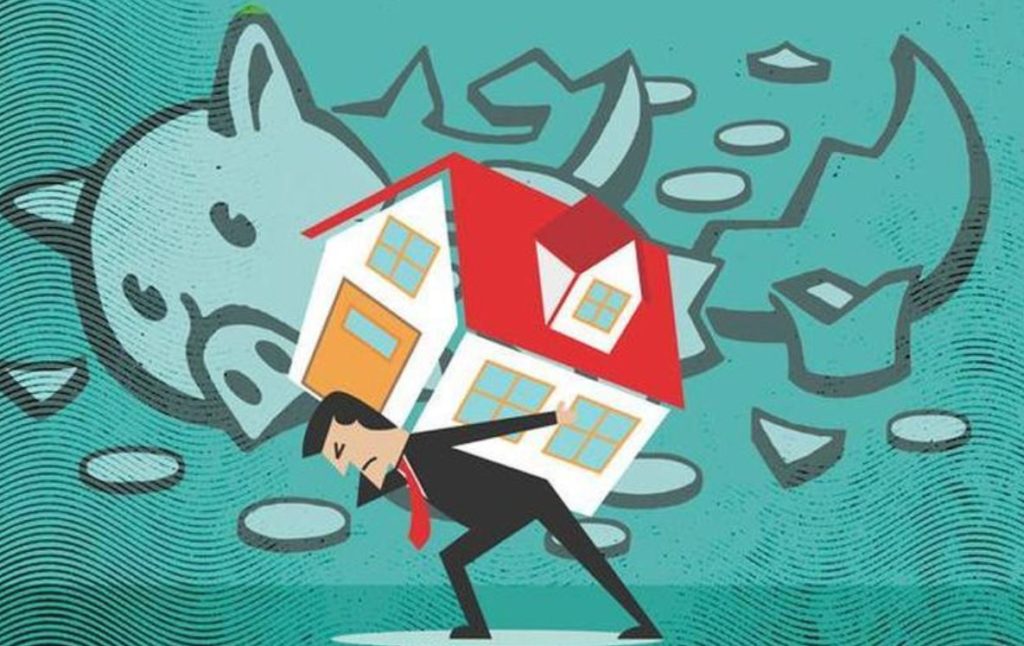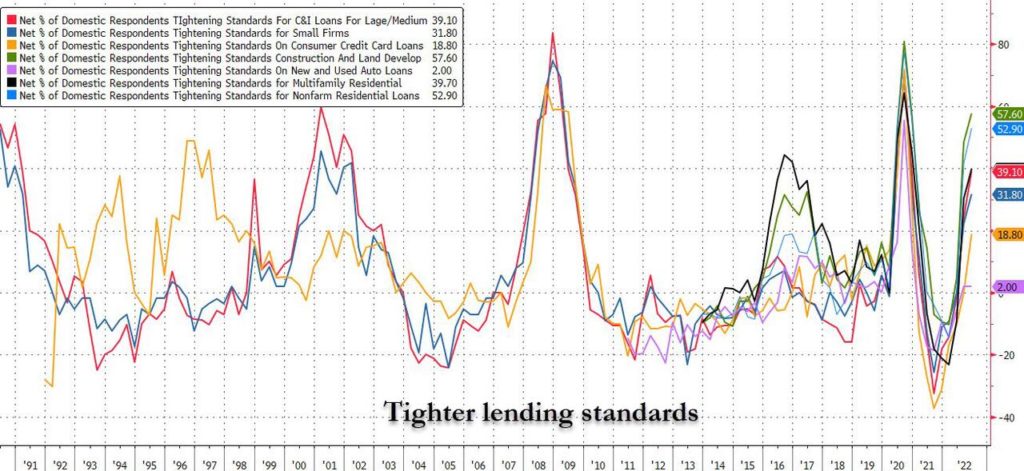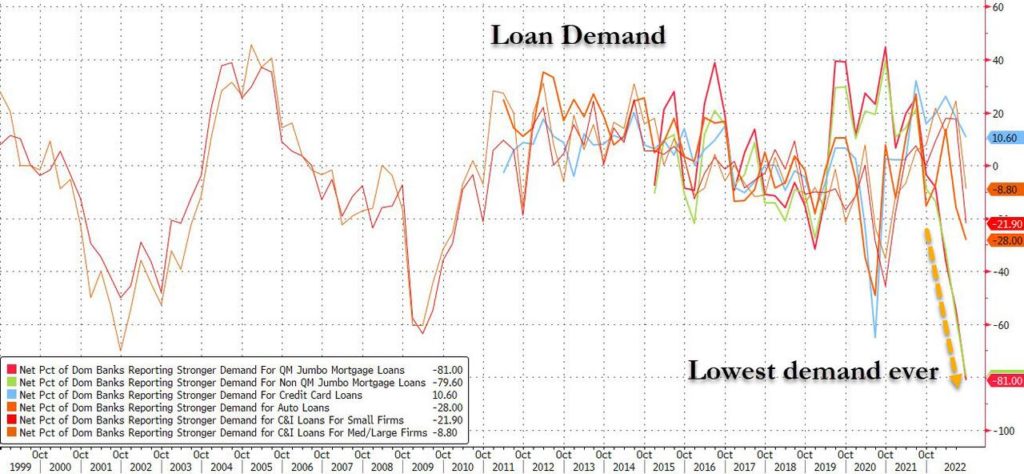 By Tyler Durden
By Tyler Durden
In all the chaos over the past few days, we missed the release of the Fed’s latest Senior Loan Officer Survey which came out Monday. The results were striking: as one would expect from an economy in recession (and in some cases, depression), in nearly all categories, banks are reporting both tighter lending standards and sliding demand for new loans…
… and nowhere more so than in mortgages, both qualifying and otherwise, where demand has collapsed to “depression” levels as a result of the fastest ever surge in interest rates.
While C&I loans are still doing OK, and demand for credit card debt is still near record highs – to be expected at a time when revolving credit debt is soaring at the fastest pace in history, record APRs be damned – it’s only a matter of time before these two core credit categories follow mortgage loan demand into purgatory, at which point the US economy will be a complete disaster.
Here are some more details courtesy of Goldman:
- Lending standards for commercial and industrial (C&I) loans tightened in 2022 Q3. 39% of banks on net tightened lending standards for large and medium-market firms (vs. 24% on net in the previous quarter), while the number of banks tightening lending standards for small firms increased to 32% (vs. 22% on net in the previous quarter). 30% of banks on net widened spreads of loan rates over the cost of funds for large firms (vs. 12% on net in the previous quarter), while 25% on net widened spreads for small firms (vs. 13% on net in the previous quarter).
- For banks that tightened credit standards or terms for C&I loans or credit lines, all cited a less favorable or more uncertain economic outlook as playing a role; 61% cited reduced tolerance for risk; 59% cited a worsening of industry-specific problems; 39% cited decreased liquidity in the secondary market for these loans; 26% cited less aggressive competition from other lenders; 20% cited a deterioration in their bank’s current or expected capital position; and 20% cited a deterioration in their current or expected liquidity position as playing a role.
- Demand for C&I loans from large- and medium-sized firms weakened in Q3. 9% of banks on net reported weaker demand for C&I loans for large and medium-market firms, compared to 24% on net reporting stronger demand in the previous survey. 22% of banks reported weaker demand for C&I loans from small firms, compared to 18% reporting stronger demand the previous quarter.
- Standards for commercial real estate (CRE) loans tightened in 2022Q3. 58% (+10pp) of banks on net reported tightening credit standards for construction and land development loans, and 40% (+10pp) on net reported tightening lending standards for loans secured by multifamily residential properties. The number of banks that reported tightening standards for loans secured by non-farm non-residential properties increased to 53% (+11pp). Demand for loans secured by multifamily residential properties, loans secured by nonfarm nonresidential properties, and construction and land development loans all decreased.
- Credit standards on mortgage loans tightened somewhat. Standards eased slightly or were basically unchanged for non-jumbo, non-GSE eligible (-3.4pp to -3.4%) and GSE-eligible mortgages (flat at +1.7%). Meanwhile, standards tightened for Qualified Mortgage jumbo (-0.1pp to +5.2%); non-Qualified Mortgage jumbo (+3.8pp to +7.4%); non-Qualified Mortgage non-jumbo (-1.8pp to +3.8%); and subprime residential mortgages (-1.4pp to +11.1%).
- Banks’ willingness to make consumer installment loans decreased in Q3 (-7% on net vs. +5% on net previously). The portion of banks tightening credit standards for approving credit card applications increased (+19pp to +19%), and 2% of banks on net tightened standards for auto loans (flat). The portion of banks reporting stronger demand for credit card loans decreased but remained positive (-7pp to +11% on net), while demand for auto loans also declined (-12pp to -28% on net).
But loan supply and demand aside, the punchline from the survey is that “most banks assigned probabilities between 40 and 80 percent to the likelihood of a recession in the next 12 months, with no bank reporting a probability less than 20 percent. Although banks in general assigned relatively high probabilities to a recession occurring in the next 12 months, most banks reported expecting the recession to be mild to moderate, should one occur. In addition, most foreign banks assigned a probability between 40 and 80 percent that a recession would occur in the next 12 months.”
Source: ZeroHedge
Become a Patron!
Or support us at SubscribeStar
Donate cryptocurrency HERE
Subscribe to Activist Post for truth, peace, and freedom news. Follow us on SoMee, Telegram, HIVE, Flote, Minds, MeWe, Twitter, Gab, What Really Happened and GETTR.
Provide, Protect and Profit from what’s coming! Get a free issue of Counter Markets today.



Be the first to comment on "Loan Demand For Mortgage Loans Crashes To Depression Levels"